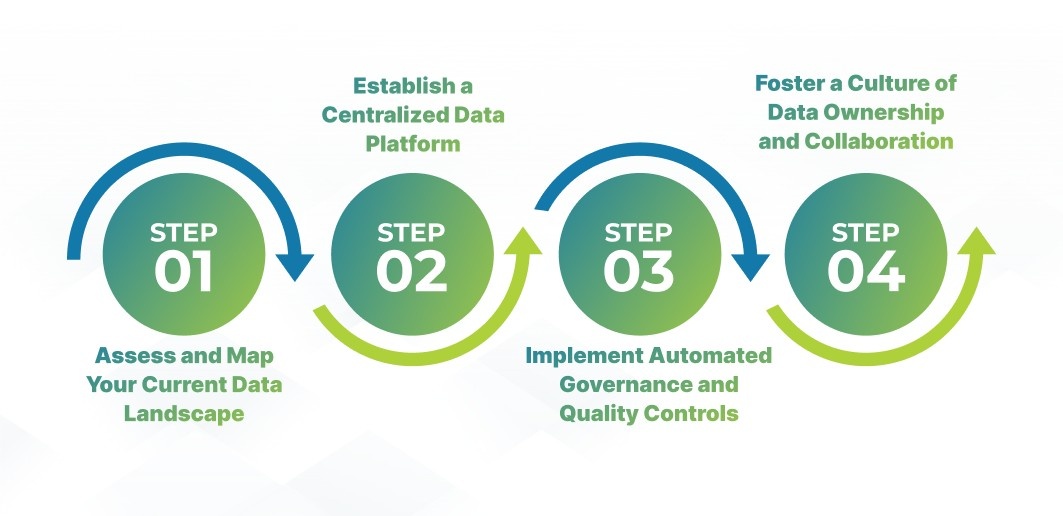
Table of Contents
ToggleHow to Get a Unified Data Hub, Even If Your Data is a Mess
Does fragmented data hinder your business decisions?
Your ability to gain insights and drive growth depends on accessible and understandable data. Many companies struggle with information scattered across disparate systems. This problem creates a significant barrier to innovation, efficiency, and real growth.
Here you will get a step-by-step guide for creating a unified data strategy to help your business grow. After implementing this, you will get quick insights for smarter decisions and a competitive advantage. Ultimately, you can transform your operations by connecting your data.
What is Unified Data?
Unified data is a strategic architectural approach to consolidate fragmented information. It integrates data from various systems into a single source.
Unified Data Importance:
This makes data accessible, reliable, and useful across an entire organization. Unified data eliminates data silos and gives businesses a complete, accurate view of their operations.
- The Challenge of Fragmented Data: Moving beyond silos is an essential evolution in modern data architecture. IBM reports that 68% of enterprises deal with data silos. These silos disrupt workflows and create widespread inefficiencies. A unified approach is now essential for businesses to stay competitive. It is no longer about simply collecting data; it’s about connecting it.
- The Problem with Inconsistent Data Quality: Even with data access, quality issues can be a major problem. Inconsistent data leads to flawed insights and bad decisions. Poor data quality costs the US economy an estimated $3.1 trillion annually, according to a recent report. This undermines trust and makes a single source of truth impossible.
- The Hurdle of Legacy Systems: Outdated legacy systems act as persistent obstacles to unification. They are difficult to integrate into today’s dynamic cloud environments. These systems are stubborn data silos that require significant time and expertise to overcome. Technical complexity is a major barrier for many companies.
Types of Unified Data Management Systems
Single-Platform Data Systems
Single-platform data management systems combine all data into a single platform.
Systems That Connect Multiple Data Tools
A unified data platform links diverse tools through integration, master data management, and data governance. It creates a single, consistent view of your data, enhancing its quality and accessibility. A data fabric is a modern approach that provides this unified view without physically moving your data.
Team-Based Shared Data Access
Unified data management includes various methods for sharing data across teams. These methods range from platforms for collaboration to data marketplaces and secure, role-based access controls.
Take Control of Your Business Data
Unified platform can help you manage and scale your business.
- Centralized Management
- Improved Data Quality
- Future-Proof Your Business
Step-by-Step Guide for Successful Data Unification
With a strategic approach, you can create a unified data landscape. This journey begins by moving from theory into practice. Follow these four steps:
Step 1: Assess and Map Your Current Data Landscape
First, you must understand where your data is present. Conduct a complete audit to identify all data sources. Create a detailed map of your systems and their interconnections. This assessment provides the necessary foundation for your strategy.
Step 2: Establish a Centralized Data Platform
A central hub is the essential foundation for unification. This can be a data warehouse, a modern data lake, or a sophisticated data fabric. The unified data platform serves as a single point of access. It allows teams to query and integrate data without physically moving it.
Step 3: Implement Automated Governance and Quality Controls
Unification projects fail because of poor data quality. Automated governance ensures data is clean and reliable for analysis. Gartner reports that poor data quality costs organizations an average of $12.9 million annually. Your data will remain secure with these controls.
Step 4: Foster a Culture of Data Ownership and Collaboration
Technology alone is not enough for success. A unified culture is also critical for a successful strategy. Every department must take responsibility for data quality. Leaders should encourage collaboration to break down silos.

Pros and Cons of Unified Data Management
| Pros | Cons |
|---|---|
| Improved Data Quality and Consistency | Change Management and User Adoption |
| Enhanced Decision-Making | |
| Increased Operational Efficiency | |
| Stronger Security and Compliance | |
| Easier Compliance and Reporting | |
| Fast, Reliable Data Access |
The Future of Unified Data Hub: What's Next?
Data management is constantly evolving with technology. The next wave of innovation moves toward a more user-centric architecture. Key trends are already shaping the future of data unification, as businesses can no longer rely on yesterday’s data. The future is instant, event-driven systems that process information as it’s generated.
Conclusion:
Unifying your data is a necessity for businesses and no longer a luxury. A cohesive data strategy transforms fragmented information into your greatest asset. This shift helps make smarter and faster decisions.
Ultimately, a unified data foundation is key to creating an agile, future-proof business. Want to take control of your data and manage it effortlessly? Become an early adopter of our AI-driven unified CRM and ERP platform, Integrow.
Secure Your Spot Before It’s Gone
Only 6 companies per industry will shape what comes next.
Be one of them and lead the change, not chase it.


